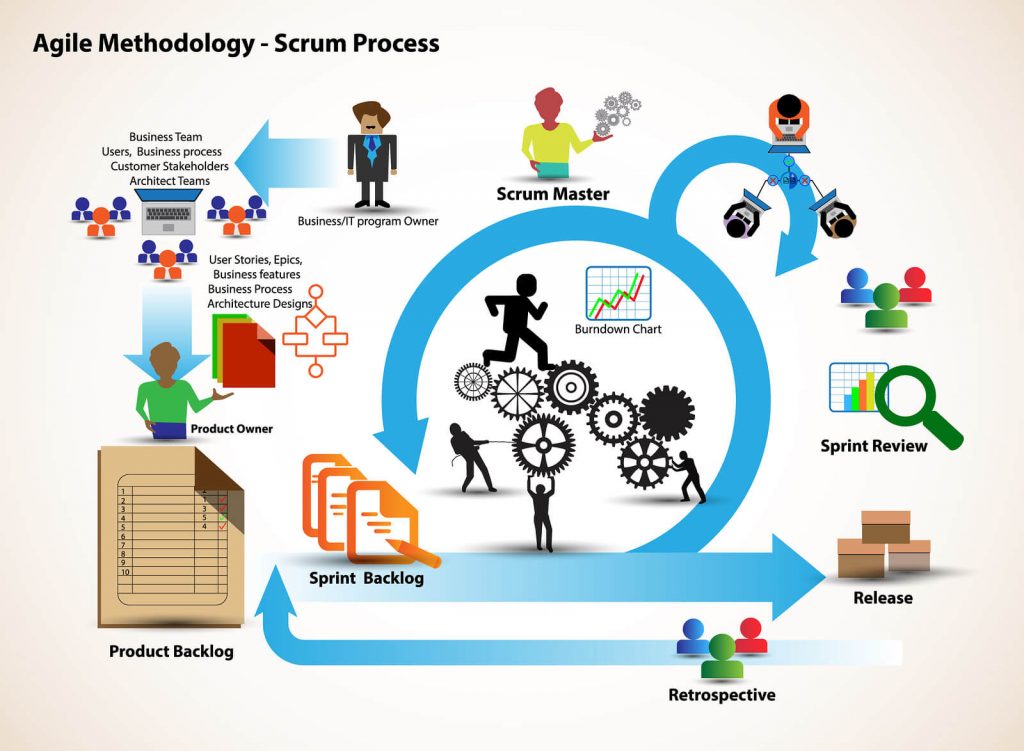In this unit, we are learning about Project Management, so we are going to talk about the Scrum approach. This tool is one of the options you can pick to get along with the projects.
Scrum is one of the agile Project Management methods, providing guidance through a flexible process with short release cycles, by which teams can continuously learn and improve. Scrum offers a structure, however, this can be adapted completely freely to individual requirements. Named structure consists of the so-called three Scrum-Artifacts, which are the Product Backlog, the Sprint Backlog and the Increment. In the following section, each step of the Scrum process will be examined in more detail:
o Product Backlog: The Product Backlog is the main list of tasks to be completed, meaning it can basically be considered the to-do list for the project. It includes for instance requirements, features, and enhancements related to the project. Created by the project manager, it is constantly reprioritized.
o Sprint Backlog: The Sprint backlog can include, for instance, a list of items, user stories, and bug fixes. Before each sprint, the team decides in a meeting which items from the product backlog they want to work on.
o Increment: The Increment is basically the final product resulting from a sprint, such as any kind of milestones or goals achieved.

There are three different groups involved in Scrum: The Product Owner, the Scrum Master and the Development Team.
- The Product Owner is the person responsible for the entire project and the resulting products. During the sprints, he analyzes changes in the market, customers and competitors. This allows him to prioritize all tasks for the development team.
- The Scrum Master is responsible for the success of the Scrum. Basically, he has to make sure that everything runs smoothly. He is the mediator between the product owner and the development team. He also has to plan the required resources for the Sprint Plannings, Sprint Reviews and the Sprint Retrospectives.
- The Development Team usually consists of 5-7 members. They are responsible for completing the actual tasks. The team members have different skills that they provide to each other. The spirit of the team should be mutually supportive.
Here is a brief summary about the most important pros and cons that can find at the moment of using the scrum.
PROS
- It is simple to visualize the method throughout its development
- Possibility to change implement changes at any point of the project through highflexibilty
- Clients/Customers are involved in the process
- Simple testing methods and simple testing procedure to ensure better work and quality
CONS
- If a member of the project leaves the team during the process it will have a bad impact on the whole project outcome
- With no deadline to deliver the project, it is not always the fastest method
- This method is mostly not suited for big teams, because great cohesion is required, which is easier to achieve for smaller groups
- Because the teams are small, there is greater pressure on the single team-member to deliver a product properly
In conclusion, it can be said that the Scrum method is an agile method, with high flexibility and the possibility of implementing changes at all times during the process, involving the client’s opinion and external changes. However, in order to implement it, you need a well-functioning organization and a team that is prepared for it.
Aufbau der Scrum Methode – epunks GmbH
Die Agile Scrum-Rollen – einfach erklärt – Vollcom Digital (vollcom-digital.com)
https://blog.wearedrew.co/ventajas-y-desventajas-de-la-metodologia-scrum
https://www.simplilearn.com/scrum-project-management-article
Authors
Katharina Laura Steiger
Timo Bernd Schellinger
Lili Vankó
Juan Segundo Cianciarulo
Julia Banovici
See featured article:
